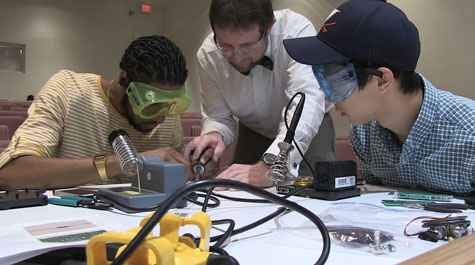W&M music students create modern sounds in an old-fashioned way
Ewell Hall, the home of William & Mary’s music department, is commonly filled with sound. But in Christopher DeLaurenti’s computer music class, those sounds are a little out of the ordinary. On a particular Friday in late October, high-pitched beeps and buzzing noises reminiscent of an alarm clock and an ’80s video game arcade ascended into a collective ear-piercing drone, eliciting expressions of triumph among a goggle-clad crowd of students.
“We can go through and say we heard square waves and triangle waves and some noise and distortion,” said DeLaurenti, senior lecturer of sound and music. “But really what we were hearing was the sound of exploration — of students building these things and trying to figure out how to play them and how to discover them as musical instruments.”
{{youtube:medium:left|8pWTEFEZmOk, In class with DeLaurenti: Atari punk synthesizers}}
Their unusual instruments were palm-sized synthesizers hand-built by each student in the span of an hour from a jumble of wires, knobs and other knick-knacks. Under the instruction of Jake Joseph, manager of assessment and accreditation in the W&M School of Education who teaches how to build and design electronics on the side, students fastened each piece individually onto a custom-designed circuit board through the practice of soldering, which fuses two metals together while conducting electricity.
“We’re to the point in society where we’re a little divorced from how things are made,” said Joseph. “We have all of these devices around us all the time, but we don’t really give a lot of thought as to what the guts are actually doing and how they work.”
DeLaurenti first connected with Joseph at a workshop in the Small Hall Makerspace, where Joseph was leading a demonstration on soldering, an age-old technique used to make some of the earliest electronics by hand. Though the technique is primitive, it affords more flexibility in design and, from a musician’s perspective, more range of sound.
“With an analog synth, you will never get the same sound ever again,” said DeLaurenti. “A mere millimeter turn of the knob will all of a sudden produce a completely different sound. And unlike a digital synth, there are no presets or digital storage, so it really makes everything evanescent. It’s timeless in a way an acoustic instrument is, but it has knobs instead of keys, strings or reeds.”
Joseph created the plan for the particular synth used in class from a Creative Commons design called the Atari punk console, named for its resemblance in sound to an old 8-bit video game machine. He then modified the basic circuit diagram design to be suitable for first-time soldering students.
“I wanted to pick something that would have a high rate of success in class but that students would still think was engaging and useful,” said Joseph.
Following the class, each student was able to keep their creation for further manipulation, future projects or performances. Perhaps more importantly, they also took home the invaluable knowledge of the inner workings of analog synthesizers and the skills used to create them, which DeLaurenti said will also be helpful in understanding the digital realm of sound more clearly.
“Music can be made in so many different ways, and the more ways that we can discover, explore and share with each other, the broader the definition and the broader our idea of and experience with music can be,” said DeLaurenti.
 Skip to main content
Skip to main content

